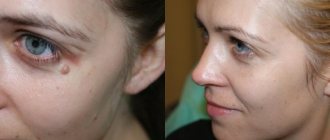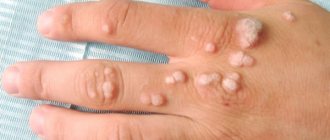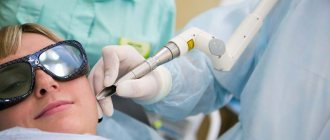Laser mole removal is a procedure that is quickly tolerated by the patient. The main advantage is a good cosmetic result. Depending on the type of mole being removed, different lasers may be used. Whether mole removal will be effective and what the cosmetic result will be after healing depends on the experience of the doctor and the chosen laser.
Of all mole removal methods, laser removal provides the best patient reviews. Especially when removing moles from the face, when the most cosmetic result is important. The procedure is painless (performed under local anesthesia), fast, and causes minimal discomfort. Laser procedures do not limit the patient’s daily activity - frequent dressings are not required, local disinfection is sufficient.
Should moles be removed at all?
A mole needs to be removed only in two cases - if it causes physical or psychological discomfort. When a neoplasm is regularly injured during changing clothes or performing hygiene procedures, it is better to resolve the issue of removal for the sake of your safety. Moles on the face and other exposed parts of the body spoil the appearance and cause complexes and self-doubt. This problem especially worries young girls who always want to remain attractive and not think about how to disguise external defects. You should also remove moles that, without injury, have changed their shape and color, began to hurt and increase in size. It is advisable to remove moles that are located on the palms, soles of the feet, and scalp, where there is a high risk of injury. If you often go on seaside holidays, sunbathe a lot and have large moles on exposed areas of your body, you may want to consider removing them for your own safety. But only after consultation with a tumor removal specialist.
The mechanism of warts appearance
You can become infected with warts, that is, you can become infected with the virus itself, which provokes the appearance of these tumors that are unpleasant to look and feel (more than 60 types of papillomavirus are the causative agents of the disease). The simplest and most common way of infection is tactile contact (a simple handshake, friendly contact, a walk holding hands). You can also become infected through any household items, on public transport, through door handles, and so on. The virus lives in the external environment for about 2-3 hours. After the virus enters the skin, it penetrates through microcracks into the deep layers and settles in the nervous tissue (this is why warts often appear during stress, depression, nervous strain and nervous shock). It has also been noted that persons suffering from excessive sweating are susceptible to the disease. Therefore, it is no coincidence that from childhood we are taught to wash our hands after going outside, before eating, after coming home from school.
Plantar warts appear when wearing low-quality shoes, which provoke constant sweating of the feet, and since a damp environment is a favorite place for the virus, a person has a high probability of developing the disease in this particular part of the body. This is most often observed in children and adolescents. Usually a person may not even be aware that he is a carrier of the virus. But one day he will definitely unexpectedly discover a tumor on his hand (or in another place). The virus in the human body can live for more than one year until the moment when some provoking factor provokes the virus to come out (for example, the same severe stress). The virus moves freely along nerve pathways, so a wart can appear in the most unpredictable place (but there are also those that appear in the same place all the time, with some frequency). There is also a possibility that they will never appear, even if the person is a carrier of the virus.
Now it should be said that the relevance of this problem is due not only to cosmetic defects and aesthetics, but also to the possibility of malignant degeneration (there is a category of warts that over time can degenerate into a malignant tumor).
Examination of a mole before removal?
Before removing a nevus, it must be examined to exclude the malignant nature of the neoplasm (consultation with an oncologist, histology). Each mole that you want to remove on your own initiative should be at least visually examined. If the mole is on a hidden part of the body, small in size and completely small in size, you can simply observe it for a while. In any case, the decision to remove any skin growths should be made together with your doctor.
Laser wart removal
Today, the most effective and safest method is laser removal of warts. The procedure for removing warts is carried out using Italian laser equipment from DEKA with a neodymium laser with a wavelength of 1064 nm. The laser beam is directed only at the wart and its root, and this is very important, since not all methods for removing warts affect the root, and if the wart root remains unaffected, the wart grows again. When a wart is exposed to a laser, coagulation of protein structures occurs. After laser treatment, there are no living cells left in the wart and its root, they die, after a week the wart falls off, and you get healthy and beautiful skin! Laser wart removal is a painless procedure with no side effects. Recurrence of a wart after laser removal is almost impossible.
Where can you check moles in St. Petersburg for malignancy?
If you have a problematic mole and would like to have it checked for malignancy and removed, please contact our clinics. Removal of tumors is carried out by experienced specialists who treat each patient carefully and responsibly - dermatocosmetologist, dermatologist, laser removal specialist, dermatologist-oncologist. Moles are tested for malignancy in the laboratory immediately after collecting the material. If you decide to remove a mole at the nearest beauty salon, they will not provide you with this service, which means there will be no opportunity to assess the nature of the neoplasm, which is very important when diagnosing cancer. Laser mole removal can be done in our clinics.
What causes birthmarks on the face?
The following are the causes of birthmarks on the face:
- Genetic predisposition. If parents have a significant number of moles, a similar phenomenon is observed in children in 80-90% of cases.
- Hormonal changes. With concomitant immune imbalance, an increase in the number of melanocytes and their atypical location in the skin of the face may occur. This phenomenon is typical for adolescence, pregnancy, breastfeeding, and menopause. The appearance of new spots is expected against the background of diseases of the thyroid gland and adrenal cortex.
- Pathologies of the heart and blood vessels. Heart disease, coagulation disorders, increased thrombus formation, and taking medications that interfere with blood clotting provoke the appearance of vascular nevi.
- Exposure to ultraviolet radiation. This factor influences the appearance of genetically determined birthmarks.
How is mole histology performed?
Thanks to histological examination, cancer cells can be detected even at the stage of their inception.
Indications for mole histology:
- redness of the skin around the tumor;
- small ulcers on the surface of the nevus;
- burning or pain in the mole area;
- change in color, size, shape of the tumor.
Histology is performed with the procedure of surgical excision of the mole. A small tissue sample is removed and sent for further examination. In the laboratory, biological material is placed in a special suspension and examined under a microscope. Diagnosis is based on the analysis of pigment-forming cells - melanocytes. Laboratory testing may take up to 14 days.
Are there any restrictions after mole removal?
A small crust forms at the site of the mole, which, after complete drying, comes off on its own, leaving clean, healthy skin in its place. Under no circumstances should this process be accelerated, because an unsightly scar may form in place of the crust. You should not sunbathe for a month after removing a mole. Before going outside, if it is an open area of the body, use a cream with SPF 50+, which provides a good level of protection against ultraviolet rays.
Restrictions that must be followed for 2-3 weeks after mole removal:
- Avoid contact with water
- Refrain from visiting baths, saunas, swimming pools, and open water bodies.
- The place where the nevus used to be must be protected from any thermal effects.
- Both natural and artificial tanning in a solarium are prohibited.
Removing birthmarks and port-wine stains
Laser removal of birthmarks and port-wine stains is a very effective and popular procedure today. In the distant past, birthmarks on the human body were called nothing less than the “seal of Satan.” Today the attitude towards these entities is not so strict. And they are not credited with mystical or any other secret properties. Almost all people have such spots, regardless of skin color and race. For some people they are small and do not cause any discomfort. And in others they grow to impressive sizes and can cause discomfort. For some they give a special charm, while others simply get used to them. But vascular nevi are not as harmless as they seem. Know that there is always a risk that a birthmark may one day turn into a malignant tumor.
Indications for removal:
- Injured regularly (hair removal, razor),
- friction (belt, collar, straps).
- Degeneration (change in color or shape, appearance of scales, bleeding, increase in size, pain).
It is important to know that you absolutely cannot touch, much less remove, any nevi yourself. A safe, innovative and very effective method is laser birthmark removal.
Advantages:
- Small vessels become thrombosed.
- Bloodlessness of the operation.
- The surrounding tissues are not injured.
- The possibility of metastases is excluded,
- No traces are left.
- Painless.
- No contact with tools.
- Fast recovery period.
The only drawback is that this method does not allow us to conduct a histological examination. Therefore, it must be done in a medical facility.
Removing birthmarks and port-wine stains
Removing birthmarks and port-wine stains
Contraindications:
- Pregnancy and lactation.
- Taking medications that increase sensitivity to light.
How is the procedure done?
If necessary, anesthesia is performed. Then the skin is disinfected and the birthmark is burned out with a laser. During the session, a slight burning sensation is allowed. A depression may remain at the site of the procedure, which will become equal to the surface of the skin in fourteen days. The duration of the session is no more than five minutes, and the rehabilitation period is only two weeks. After healing and renewal of the skin, no traces are noticeable at the site of the birthmark. Care after removal. It is very important to listen to your doctor's recommendations. To take adequate care of your skin after removing birthmarks.
To obtain a stable and sustainable result. The crust that forms must be protected from any influence (gels, water and creams). You cannot remove it by force; this can stop the process of growth of the epidermis and lead to scars. After the crust is peeled away, tender skin remains in its place. Which also needs to be protected from mechanical, thermal and ultraviolet influence.
Healing
You need to take care of the treated area until then. Until the skin on it becomes the same color as the skin around it. Effective and popular procedure, impressive size birthmark, vascular nevi
Call us for a free consultation about skin or injections. By phone +7 985 233 0025.
Or visit our cosmetic skin clinic to learn more!
Is it safe to remove moles?
Today you can often see offers to remove moles using the laser method in a cosmetology office. For safety reasons, this is absolutely not worth doing. To carry out high-quality nevus removal, you should contact specialized medical institutions, where the procedure is performed by experienced medical workers. It is possible to immediately send the material for histological examination. Beauty salons do not provide this service. If a mole is suspected of being oncological, it is not recommended to use the laser method, which does not allow taking a tissue sample.
If the technology is followed, the nevus removal procedure is absolutely safe. The laser acts locally only on tumors, without heating neighboring organs and tissues.
Preparation for the procedure
Before laser removal, the tumor is examined. First, the doctor conducts a visual examination, and then examines the tumor under multiple magnification. Dermatoscopy is a safe, non-invasive and simple diagnostic method that allows detailed visualization of not only the superficial, but also the deep layers of the skin.
Using a laser, only benign neoplasms are removed, since the neoplasm is evaporated and subsequent tissue examination cannot be carried out. If there is the slightest suspicion of a malignant process, the laser cannot be used and removal is carried out surgically with excision of not only the mole, but also part of the healthy tissue.
Before interventions, it is necessary to undergo several tests - tests for blood group and Rh factor, coagulogram, etc.
No special preparation is required for the procedure. The patient arrives at the appointed time. The procedure takes from 5 to 10 minutes, depending on the size of the tumor. To remove moles, a laser knife or erbium laser is used, the operation is performed under local anesthesia.
Care after mole removal
Within 10-14 days after laser removal of a mole, you should pay attention to your health and follow all doctor’s recommendations.
What not to do:
- Always cover the scab with a bandage or plaster - this can slow down the regeneration process.
- Expose the skin to heat - do not go to the bathhouse or sauna, sunbathe in the sun, or make warm compresses.
- Be in direct sunlight - even after the crust falls off, you must apply sunscreen before going outside (if it is a visible part of the body).
- Play sports - regardless of the location of the mole, it is necessary to exclude physical activity for 1-2 weeks.
- Take a hot bath - on the first day after the procedure, you should not wet the mole with water at all. Next, hygiene procedures must be performed with water at room temperature. The ideal option is a shower. When taking a bath, there is a risk that after steaming the protective crust will fall off and an unaesthetic scar will appear in its place. You should also not rub the mole with a washcloth.
If a mole has been removed from the surface of the palms or soles, any physical activity should be reduced as much as possible. To treat the damaged area, use only medications recommended by your doctor. If you notice swelling, redness or pain in the area where there used to be a mole, do not self-medicate, but immediately consult a doctor.
How does laser removal of warts occur?
At our clinic, doctors remove warts with a laser. Laser wart removal offers many advantages over other methods. Firstly, after treating a wart with a laser, the virus is blocked and the wart ceases to be infectious, and it also stops growing and multiplying. Secondly, the procedure for laser wart removal is absolutely painless, since a special attachment built into the laser cools the site of treatment, as a result of which a slight tingling sensation may be felt during laser wart removal. Children tolerate this procedure very easily. Thirdly, after removing a wart with a laser, there are no scars, white spots or depressions left, but only healthy and clean skin. The laser affects only the wart, without affecting healthy tissue nearby. The wart dies immediately, the laser beam penetrates to the depth specified by the doctor to remove the wart root. And then the risk that the wart will grow again is practically reduced to zero.
Flat or juvenile warts (verrucae planae verrucae juveniles) occur in adolescence or young adulthood. Usually there are a lot of such warts, they are slightly convex or almost flat or slightly rough. Warts appear very often on the arms, palms and cheeks. This type of wart is painless, but sometimes causes itching. The period of the disease can last several months or years, causing many aesthetic inconveniences, so we advise you to get rid of them. Laser removal of warts of this type is very fast and effective.










